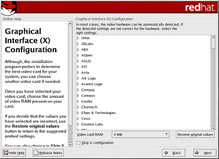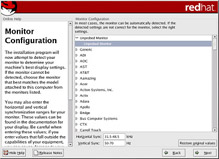X Configuration - Monitor and Customization
|
X Configuration — Monitor and Customization
In order to complete X configuration, you must configure your monitor and customize your X settings.
Video Card Configuration
If you decided to install the X Window System packages, you now have the opportunity to configure an X server for your system. If you did not choose to install the X Window System packages, skip ahead to the “Installation Complete!” section later in this chapter.
If your video card does not appear on the list, X may not support it. However, if you have technical knowledge about your card, you may choose Unlisted Card and attempt to configure it by matching your card's video chipset with one of the available X servers.

Figure 2-32. X Configuration
Next, enter the amount of video memory installed on your video card. If you are not sure, consult the documentation accompanying your video card.
| Note | You will not damage your video card by choosing more memory than is available, but the X server may not start correctly if you do. |
If you decide that the values you have selected are incorrect, you can click the Restore original values button to return to the suggested settings.
You can also select Skip X Configuration if you would rather configure X after the installation or not at all. If you do, skip ahead to the “Installation Complete!” section later in this chapter.
| Tip | To change your X configuration after you have completed the installation, type the redhat-config-xfree86 command from a shell prompt to launch the X Configuration Tool. If you are logged in as root, Linux will prompt you for the root password to continue. |
Configuring Your Monitor
The installation program will present you with a list of monitors to select from. From this list, you can either use the monitor that is automatically detected for you or choose another monitor.
| Note | If you are installing Red Hat Linux on a laptop with an LCD screen, you should select the most appropriate Generic model available. |
If your monitor does not appear on the list, select the most appropriate Generic model available. If you select a Generic monitor, the installation program will suggest horizontal and vertical sync ranges. These values are generally available in the documentation which accompanies your monitor or from your monitor's vendor or manufacturer; check your hardware documentation to ensure these values are set correctly.
| Caution | Do not select a monitor similar to your monitor unless you are certain that the monitor you are selecting does not exceed the capabilities of your monitor. Doing so may overclock your monitor and damage or destroy it. |
The horizontal and vertical ranges that the installation program suggests for the selected monitor are also displayed below the list of monitors.
If you decide that your monitor selection or the horizontal and vertical ranges are incorrect, you can click the Restore original values button to return to the original suggested settings.
Click Next when you have finished configuring your monitor.
Custom Configuration
Choose the correct color depth and resolution for your X configuration. Click Test Setting to try out this configuration. If you do not like what you see during the test, click No to choose another resolution.
| Note | If you need to exit out of the X configuration test, use the Ctrl-Alt-Backspace key combination. Please note, this will not work in some cases. |
Make sure that you test your configuration to make sure the resolution and color settings are usable.
Next, choose whether you want to boot your system into a graphical or text environment after the installation is complete. Unless you have special needs, booting into a graphical environment (similar to a Windows environment) is recommended. If you choose to boot into a text environment, you will be presented with a command prompt (similar to an MS-DOS environment).

Figure 2-34. X Customization
| Tip | To change your X configuration after you have completed the installation, use the X Configuration tool. Type the redhat-config-xfree86 command in a shell prompt to launch the X Configuration Tool. If you are not logged in as root, Linux will prompt you for the root password to continue. |
| Tip | To change from the graphical login to a text login or vice versa after installation, as root you can edit the /etc/inittab file and change the line id:5:initdefault:. 5 stands for the graphical login and 3 stands for the text login. |
|
EAN: N/A
Pages: 223
